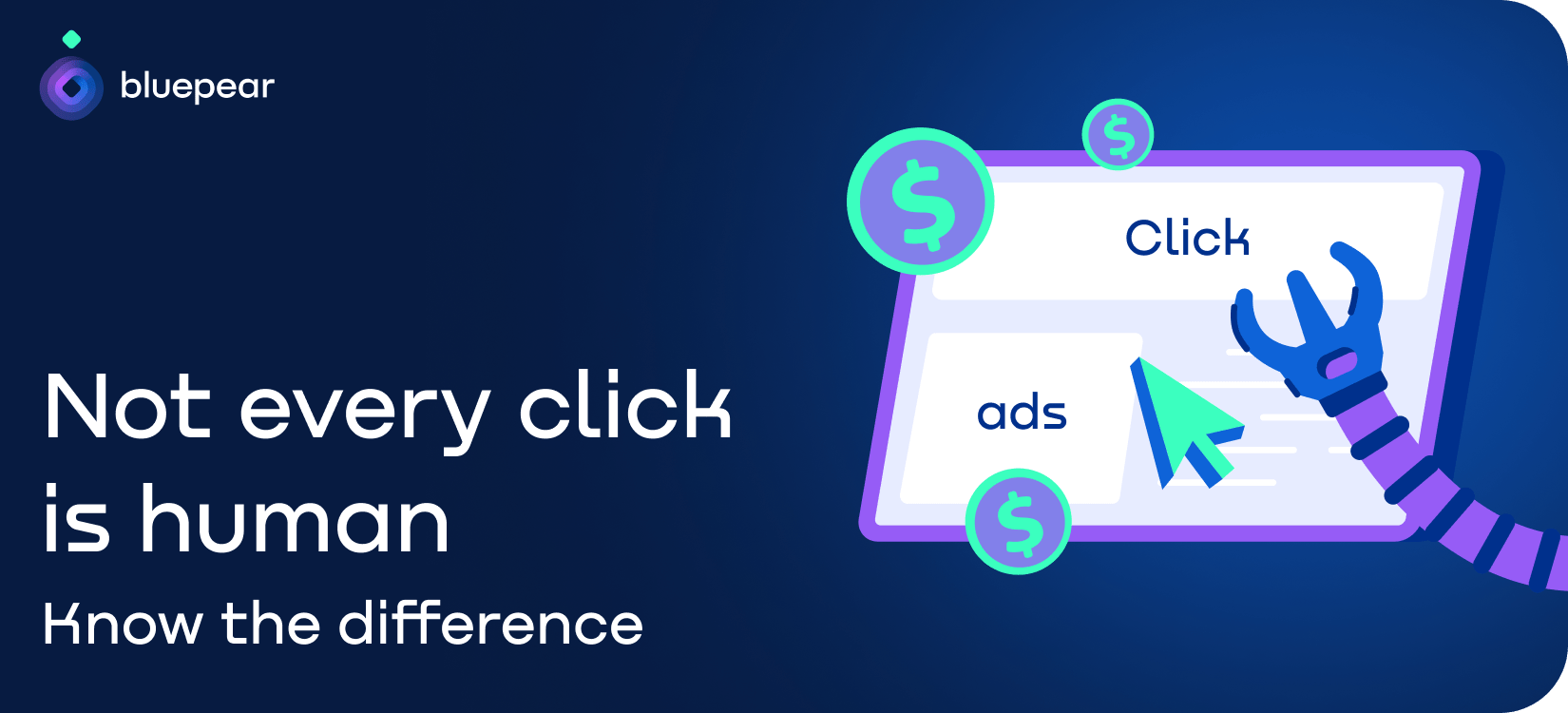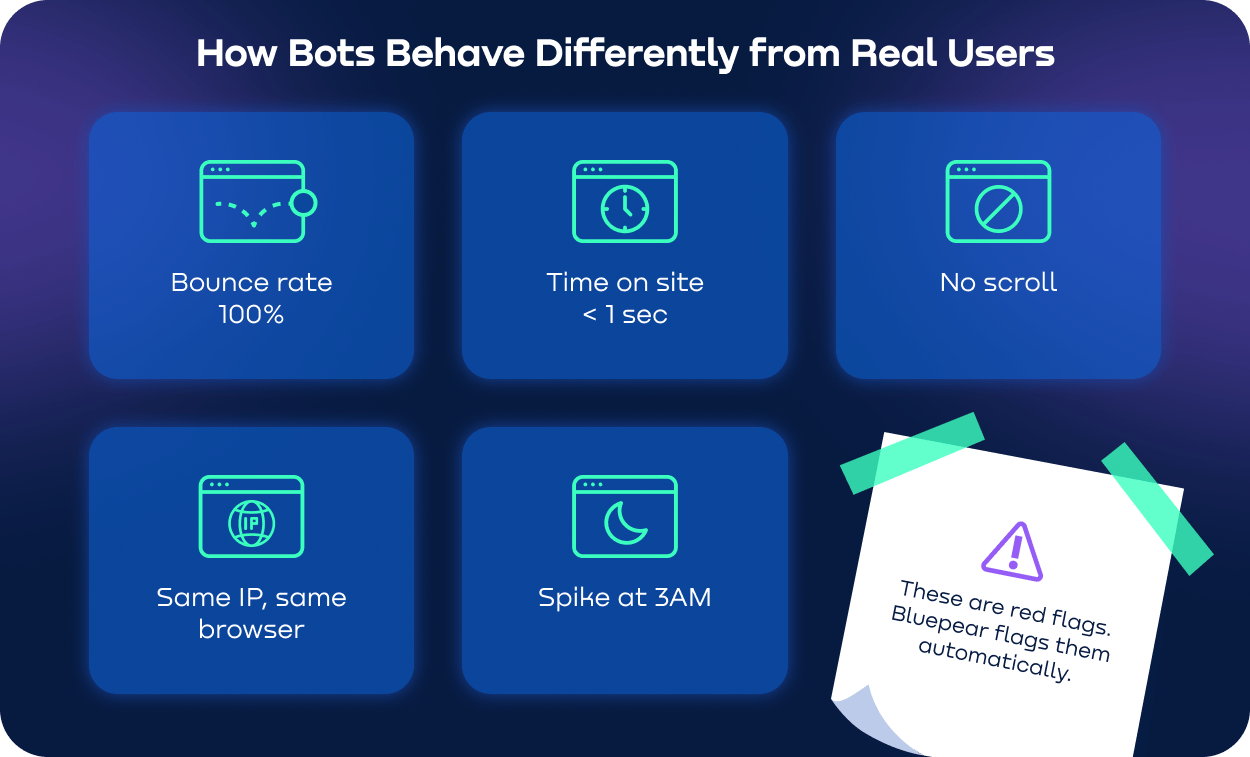
Contents
Let’s face it — not every click on your ads comes from a real person. A growing chunk of PPC traffic is driven by bots — automated programs designed to mimic human behavior online. They click, they browse, they drain your ad budget but they’ll never convert.
That’s why bot traffic detection is critical for advertisers today.
What is bot traffic? Bot traffic is fake traffic. These are clicks and visits from software, not people. Some bots are basic, randomly clicking ads. Others are more advanced, making it harder to spot them. Those bots simulate real users, but their only job is to burn through your advertising spend.
Here are some recent statistics:
• In 2025, bots officially overtook humans — over 51% of internet traffic is now automated.
• Of that, 37% is “bad bot” traffic, designed to disrupt businesses and waste ad dollars.
• Invalid traffic across ad channels costs advertisers more than $100 billion annually.
These numbers highlight why bot traffic detection should be part of every PPC strategy.
The real-world impact of bot traffic:
• A significant portion of your ad spend may go toward fake clicks that don’t generate real leads or customers.
• Increased bot activity can artificially inflate your CPC (cost-per-click), making your campaigns more expensive than they should be.
• Fake traffic distorts your campaign data, making it harder to analyze performance and make smart optimization decisions.
• Over time, undetected bot traffic can quietly drain your marketing budget, reducing overall efficiency and return on investment.
Effective bot traffic detection helps reduce fake clicks before they drain your resources.
Read on to learn how to spot website bot traffic, know if it was a bot or human, and fight against fraudsters.
Bot VS Human: How Fake Traffic Ruins Companies
What is bot traffic for brands? It is a growing problem for businesses of all sizes. These are not real people visiting your website — they’re automated programs designed to imitate user behavior.
Bot traffic detection allows brands to reduce risks by spotting non-human traffic early.
This type of affiliate fraud is designed to show you performance without bringing any real value. At first glance, it might seem harmless, but the reality is different.
• Wasted ad budget. Companies pay for clicks and impressions, but when bots generate that traffic, there’s no chance of turning visits into real customers. It drains your budget without bringing results.
Bluepear finds all the violations and sends you real-time alerts, so that you can stop paying fraudsters immediately.
• Distorted analytics. Bot traffic inflates your website numbers — page views, bounce rates, engagement. This makes your marketing reports unreliable and can lead to poor strategic decisions.
Bluepear checks your search from all the GEOs, browsers, devices and alerts your team, so decisions are based on facts, not fiction.
• Affiliate fraud. Some dishonest affiliates use bots to fake clicks, form submissions, or conversions. They collect commissions without generating genuine leads or sales, hurting both revenue and trust.
Bluepear detects suspicious affiliate activity, protecting your budget and your reputation.
• Misleading conversion rates. Bots can trigger events like form visits or button clicks, making your conversion rates look better or worse than they really are, which confuses optimization efforts.
Bluepear identifies abnormal activity and notifies you instantly, so your team can investigate and separate real users from fake ones.
• Hidden budget loss over time. Bot traffic often goes unnoticed at first. But over weeks or months, it quietly eats away at your marketing spend, reducing overall campaign efficiency.
Bluepear uncovers hidden threats and alerts you on the spot, so your budget works for real growth — not fake traffic.
Even if bots aren’t always visible, their impact on your business can be significant. Bot traffic detection is essential to protect your brand.
Now that you know what bot traffic is, let’s learn to spot it before damage is done.
5 Signs You’re Paying for Website Bot Traffic
Website bot traffic can silently drain your ad budget and distort your website data. The tricky part is, bots often look like real visitors at first glance. But there are clear signs that can help you spot affiliate violations.
1. Clicks Without Conversions
If you notice a high number of clicks but very few leads, sales, or meaningful actions, bots might be to blame. Real users usually interact with your site, bots rarely convert.
Bluepear spots the suspicious activity, so you can check the traffic source and stop wasting budget.
2. Unrealistic Time on Site
Check your analytics. If visitors stay for just a second or two, or sometimes way too long without real interaction, this could be fake traffic. Bots often trigger odd patterns.
Bluepear keeps an eye on your branded search space and notifies you when violations show up.
3. Identical User Agents or IPs
Do you see lots of visits from the same browser type or IP address? That’s a red flag and a reason to check if that is human or bot traffic. Real traffic is diverse, while bots often operate from specific servers or setups.
Bluepear tracks anomalies in your brand search and alerts you, so you can investigate repetitive bot-like activity.
4. Abnormal Spikes in Night Hours
If your traffic suddenly jumps in the middle of the night when your audience is usually inactive, it’s worth investigating if it is a human or bot. Bots often operate during off-hours.
Bluepear monitors your branded search results 24/7 and warns you when suspicious activity happens.
These are clear signs where bot traffic detection tools can step in and filter suspicious visits.

Bot VS Human: How to Tell the Difference
There are some red flags that can help you identify website bot traffic. Check them to understand if you see a bot or human visiting your website:
• User agent patterns. Bots often use the same outdated or generic user agents (browser identifiers). Real visitors show a mix of devices, browsers, and versions.
• Geo/IP anomalies. Large amounts of traffic coming from unexpected regions or multiple hits from the same IP addresses usually signal bot activity.
• Time-based spikes. Unusual traffic increases during off-hours — like the middle of the night — often indicate automated scripts running, not real users browsing.
• Low engagement rates. Bots rarely interact with content. If you see high bounce rates, very short session times, or no clicks on key elements, fake traffic could be the cause.
• Scroll behavior. Real users scroll through pages, click buttons, and engage with calls-to-action. Bots often stay static, scroll instantly to the bottom, or ignore CTAs completely.
By watching these key indicators, you can quickly understand if it is human or bot traffic. So that you can take steps to reduce its impact on your website and advertising budget.
Bot Traffic Detection: How to Block Fake Traffic
Website bot traffic wastes your ad budget and corrupts your website data. The good news is, you can spot and block most fake traffic with the right tools and steps. Here’s how to protect your campaigns:
Google Ads Filters and Exclusions
Google Ads provides tools to block unwanted traffic, whether it’s from a human or bot. If you notice traffic from certain IPs with no conversions, exclude them. You can also filter placements or keywords that attract low-quality clicks.
UTM Analysis and Logs
UTM tags help track the source of each visitor. By checking your website logs and analytics, you can find patterns like repeated visits from the same locations, devices, or times. Bots often leave digital footprints that look different from real users.
Bot VS Human Tools
There are many tools that work with bot traffic detection. They analyze visitor behavior, IP reputation, and technical details. If a visitor acts like a bot — for example, zero engagement or impossible session times — the system flags them automatically. Modern bot traffic detection systems check for patterns like repetitive actions or impossible session times.
Automated Bot VS Human Monitoring
Bluepear helps reduce website bot traffic by eliminating its source at the advertising stage. The service finds violators who launch ads for branded queries without the company's consent, use cloaking, fake landing pages or coupon sites. Fraudulent and automated traffic, including bots, often passes through these schemes. Instead of fighting bots already on the site, Bluepear blocks the channels of fake traffic. This protects the budget, reduces the number of suspicious visits and helps keep analytics clean. Such a proactive bot traffic detection approach helps maintain clean analytics and save ad spend.
Bot VS Human: Final Thought
Bot traffic isn’t a rare problem. It’s a constant threat for businesses running paid ads and managing websites. Every day, automated scripts and fake users drain budgets, distort data, and make it harder to measure real success. That’s why bot traffic detection is a must if you want to protect your marketing spend and get reliable results. Investing in bot traffic detection gives you full visibility over who interacts with your ads. Smart tools like Bluepear can help detect and block fake traffic before it burns through your budget. You’ll be able to focus on real users, improve campaign performance, and avoid wasting money on bots.
Ready to take control?

